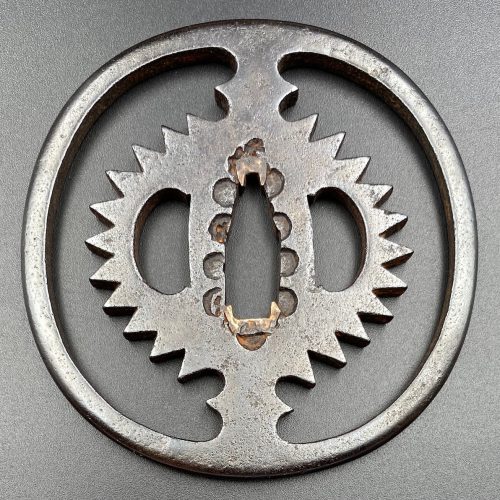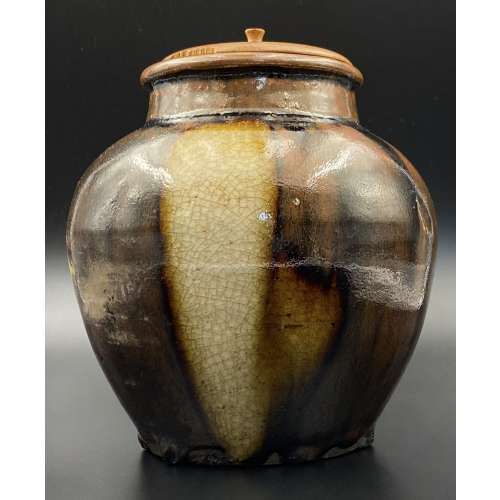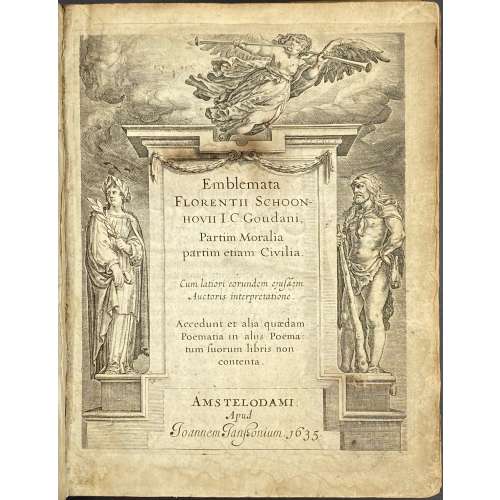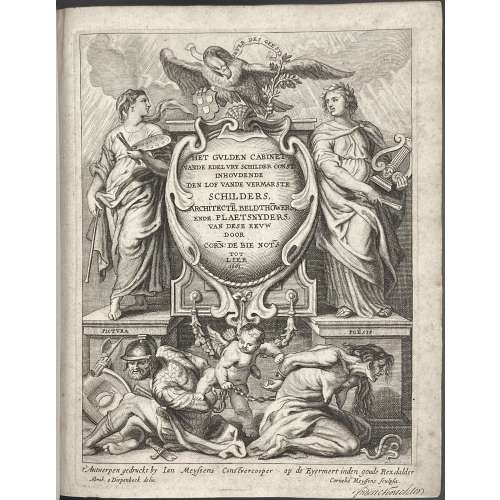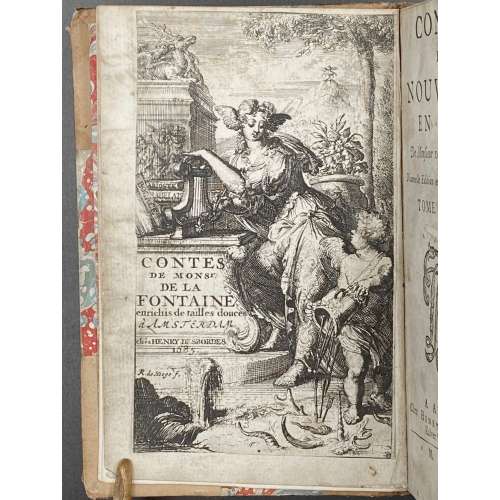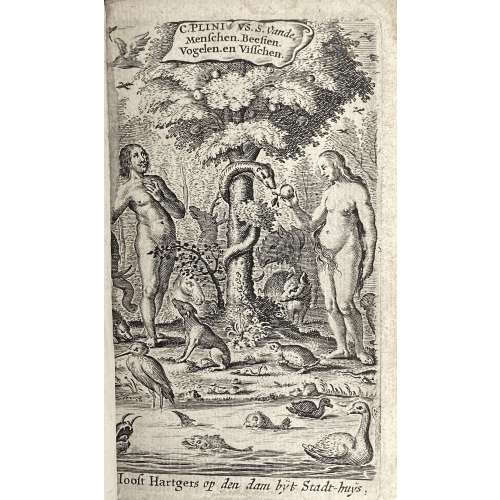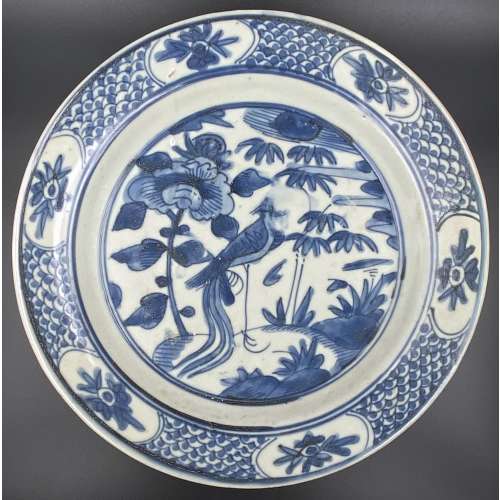Engraved title page:
- In an oval cartouche at the centre, flanked by female personifications of Painting and Poetry, surmounted by an eagle, Mars and Envy chained by Cupid below: HET GULDEN CABINET | VANDE EDEL VRY SCHILDER, CONST | INHOUDENDE | DEN LOF VANDE VERMARSTE | SCHILDERS, | ARCHITECTE, BELDTHOWERS | ENDE PLAETSNYDERS | VAN DESE EEVW | DOOR | CORN: DE BIE NOTS. | TOT | LIER | 1661. ||
- In lower margin below the image frame: t’Antwerpen gedruckt by Ian Meyssens Constvercooper op de Eyermert inden goude Rexdalder | Abrah. a Diepenbeck delin. — Cornelis Meyssens sculpsit. || Handwritten inscription below: Frederik Verachter
Letterpress title: HET GULDEN CABINET | VANDE EDEL VRY | SCHILDER – CONST | ontsloten door den lanck ghevvenschten | Vrede tusschen de tvee mach- | tighe Croonen van SPAIGNIEN | EN | VRANCRYCK, | Waer-inne begrepen is den ontstersse- | lijcken loss vande vermaerste | Constminnende Geesten | ENDE | SCHILDERS | Van dese Eeuvv, hier inne meest near het | leven as-gebeldt , verciert met veel ver- | makelijcke Rijmen ende Spreucken. | DOOR |
Cornelis de Bie Notaris binnen Lyer. ||
Pagination: 2 binder’s blank leaves, engraved t.p.,[1, 2] letterpress t.p., 3-585 [586] – approbatie, [2] – colophon / blank, 1 binder’s blank leaf.
Collation: Engr. t.p., A-Aaaa
4 Bbbb
2, plates within a collation.
Cornelis de Bie. Het Gulden Cabinet. — Antwerp: [J. van Montfort for] Jan Meyssens, 1661 [colophon: 1662].
First edition, quarto, with engraved title, added portrait of De Bie dated 1708 mounted and inserted*, illustrated with 97 full-page engravings of artists, and an engraving of a personification of the city of Rome repeated five times; bound in full contemporary Dutch parchment over boards, tooled in blind, titled on spine; ex libris Frederik Verachter (Dutch, 1797 – 1870), archivist of the Antwerp city library, with pages of notes in his hand, signature to title, and inserted leaf with extra biographical information about one of the 280 artists of the Low Countries profiled and illustrated in this volume; contents good; ex libris Gustave Van Havre (Dutch, 1817 – 1892), with his armorial bookplate inside the front board, 24 x 19.5 x 4.5 cm.
Catalogue raisonné: J. F. Van Someren (1888) pp. 200-202.
* CORNELIUS DE BIE. ÆT. 81. 1708. | Dat Ick op D'aard Niet Anders Ben | Als Stof En Assen Ick Beken: | En Alle Mijnen Arrebeijd | Noch Van Veel Minder Weerdigheijt. || J. C. de Cock delin: — H. F. diamaer Sculpsit Antv:
Ref.:
Royal Collection Trust.
Backer, Jacob de (Flemish, c. 1555 – c. 1585) (artist)
Balen, Jan van (Flemish, 1611 – 1654) (artist)
Bally, David (Dutch, 1584 – 1657) (artist)
Beck, David [Beek] (Dutch, 1621 – 1656) (artist)
Bie, Cornelis de (Flemish, 1627 – 1711) (author)
Bloemaert, Abraham (Dutch, 1565 – 1658) (artist)
Borcht I, Hendrik van der, the Elder (Flemish, 1583 – 1651) (artist)
Borcht II, Hendrik van der, the Younger (German 1614 – 1676) (artist)
Bouttats, Frederik, the Elder (Flemish, 1590 – 1661) (attributed to) (engraver)
Bramer, Leonard [Leendert] (Dutch, 1596 – 1674) (artist)
Bronckhorst, Jan Gerritsz van (Dutch, 1603-1661) (artist)
Bylert, Jan van (Dutch, 1603 – 1671) (artist)
Caukercken, Cornelis van (Flemish, 1626 – 1680) (engraver)
Collin, Richard (Luxembourgish, 1627 – 1698) (engraver)
Coques, Gonzales (Flemish, 1614 – 1684) (artist)
Cossiers, Joannes (Flemish, 1600 – 1671) (artist)
Danckerts de Rij, Peter (Dutch, 1605-1660) (artist)
Dipenbeeck, Abraham van (Dutch, 1596 – 1675) (artist)
Does, Antony van der (Flemish, 1609 –1680) (engraver)
Dyck, Anthony van (Flemish, 1599 – 1641) (artist)
François, Pierre (fl. 1643) (artist)
Hecke, Jan van den, the Elder (Flemish, 1620 – 1684) (engraver)
Heil, Daniel van (Flemish, 1604 – 1664) (artist)
Heil, Jan Baptiste van (Flemish, 1609 – 1685) (artist)
Heil, Leo van (Flemish, 1605 – c. 1664) (artist)
Helt Stockade, Nicolaes van (Dutch, 1614 – 1669) (artist)
Hollar, Wenceslaus [Hollar, Václav; Wenzel] ( Bohemian, 1607 – 1677) (artist)
Hondius I, Hendrick [de Hondt] (Flemish-Dutch, 1573 – 1650) (artist)
Janssens, Cornelis van Ceulen [Johnson, Cornelius] (Flemish-Dutch, 1593-1664) (artist)
Jode I, Pieter de, the Elder (1570 – 1634) (engraver)
Jordaens, Jacob (Flemish, 1593 – 1678) (artist)
Lint, Peter van (Flemish, 1609 – 1690) (artist)
Meyssens, Cornelis (Flemish, 1639 – fl.1673) (engraver)
Meyssens, Joannes [Johannes, Jan, Jean] (Flemish, 1612 – 1670)
Mola, Pier Francesco (Italian, 1612 – 1666) (artist)
Monte, Deodat del [Mont, Deodat van der; Delmont, Deodatus] (Flemish, 1582 – 1644) (artist)
Montfort, Jan van (fl. c. 1595 – 1644) (printer)
Padoanino, Francisco (Italian, 1660) (artist)
Poelenburgh, Cornelis van [Poelenburch] (Dutch, 1594 – 1667) (artist)
Pontius, Paulus (Flemish, 1603 – 1658) (engraver)
Quellinus, Erasmus, the Younger (Flemish, 1607 – 1678) (artist)
Reni, Guido (Italian, 1575 – 1642) (artist)
Sadeler II, Egidius (Flemish, c.1570 – 1629) (artist)
Saftleven, Herman, the Younger (Dutch, 1609 – 1685) (artist)
Seghers, Gerard (Flemish, 1591 - 1651) (artist)
Snyers, Hendrik (Flemish, 1611 – 1644) (engraver)
Soutman, Pieter Claesz (Dutch, 1593/1601 – 1657) (artist)
Steen, Franciscus van der (Flemish, 1625 – 1672) (engraver)
Teniers, David, the Younger (Flemish, 1610 – 1690) (artist)
Venne, Adriaen van de [Adriaen Pietersz] (Dutch, 1589 – 1662) (artist)
Voet, Alexander, the Elder (Flemish, 16-8/1613 – 1689) (engraver)
Vorsterman, Lucas, the Elder (Flemish, 1595-1675) (engraver)
Waumans, Conraed (Flemish, 1619 – 1675) (engraver)
Willaerts, Adam (Dutch, 1577 – 1664) (artist)



